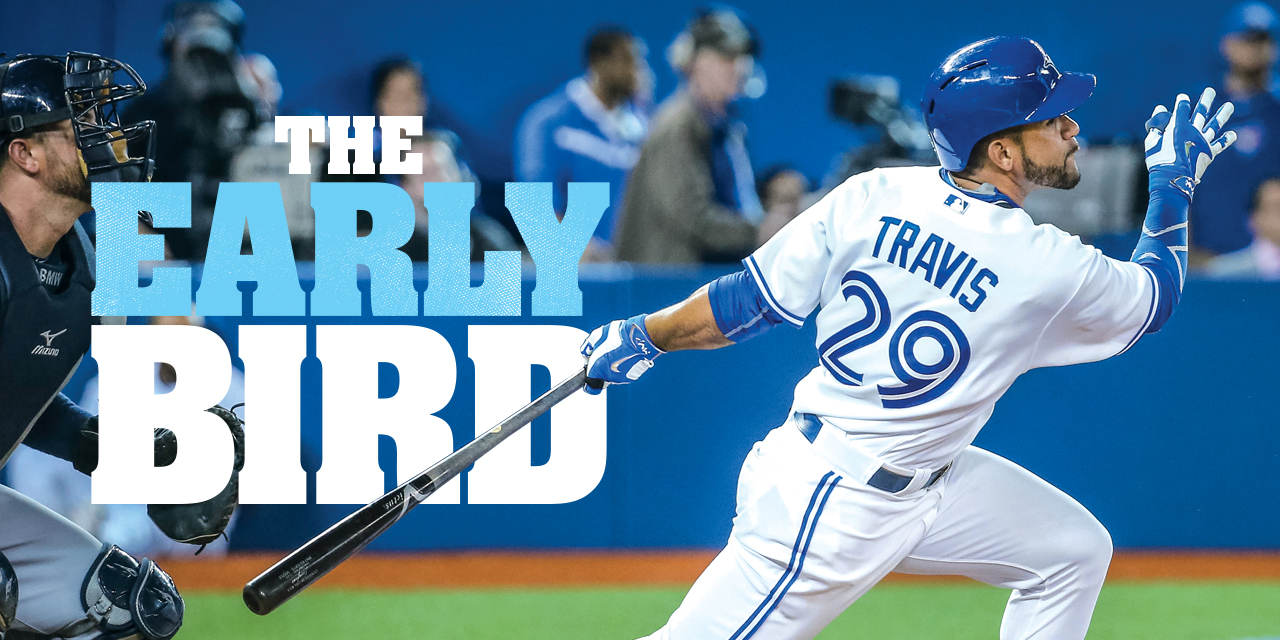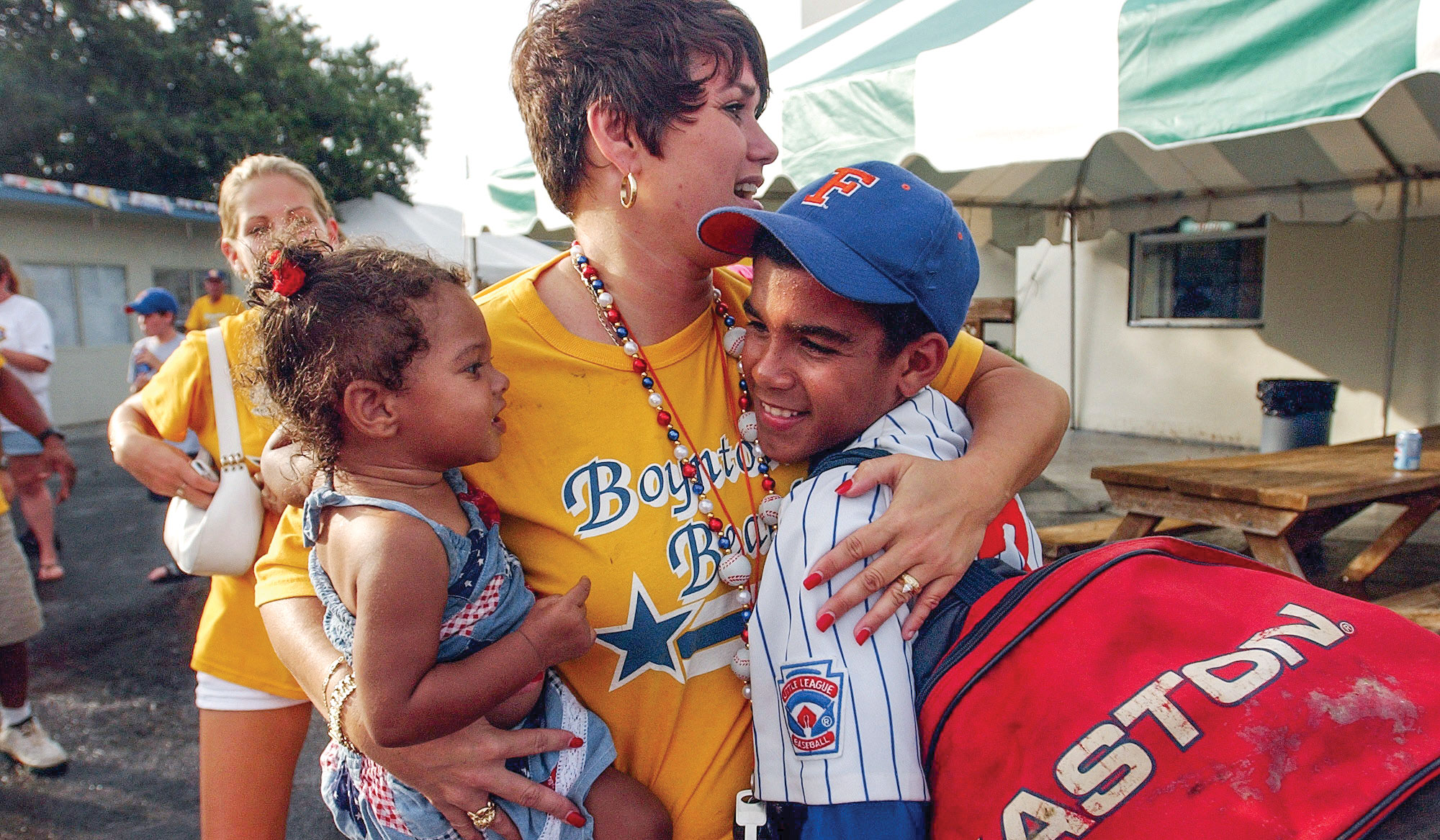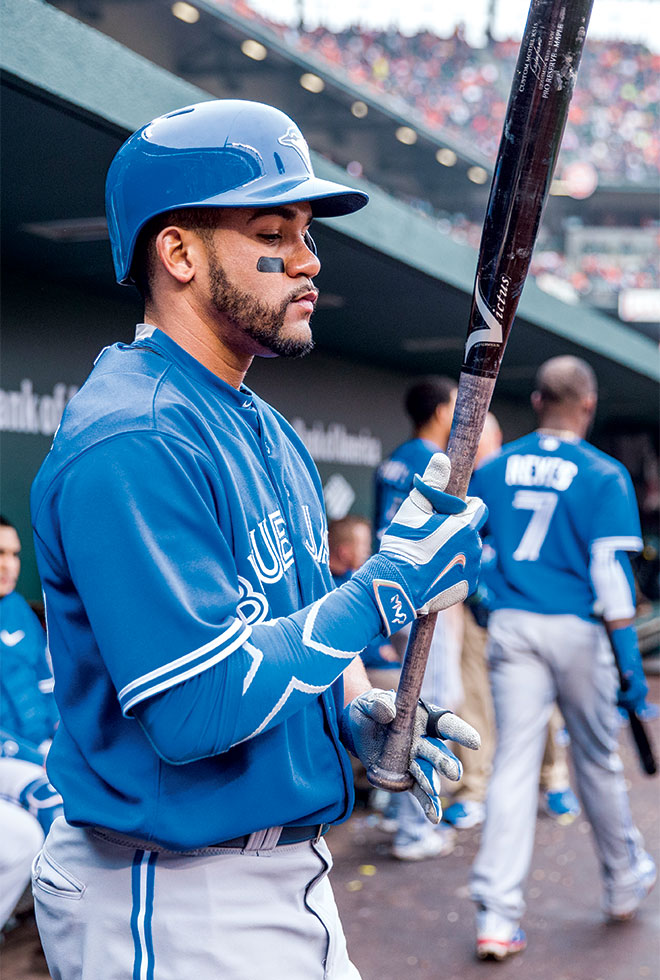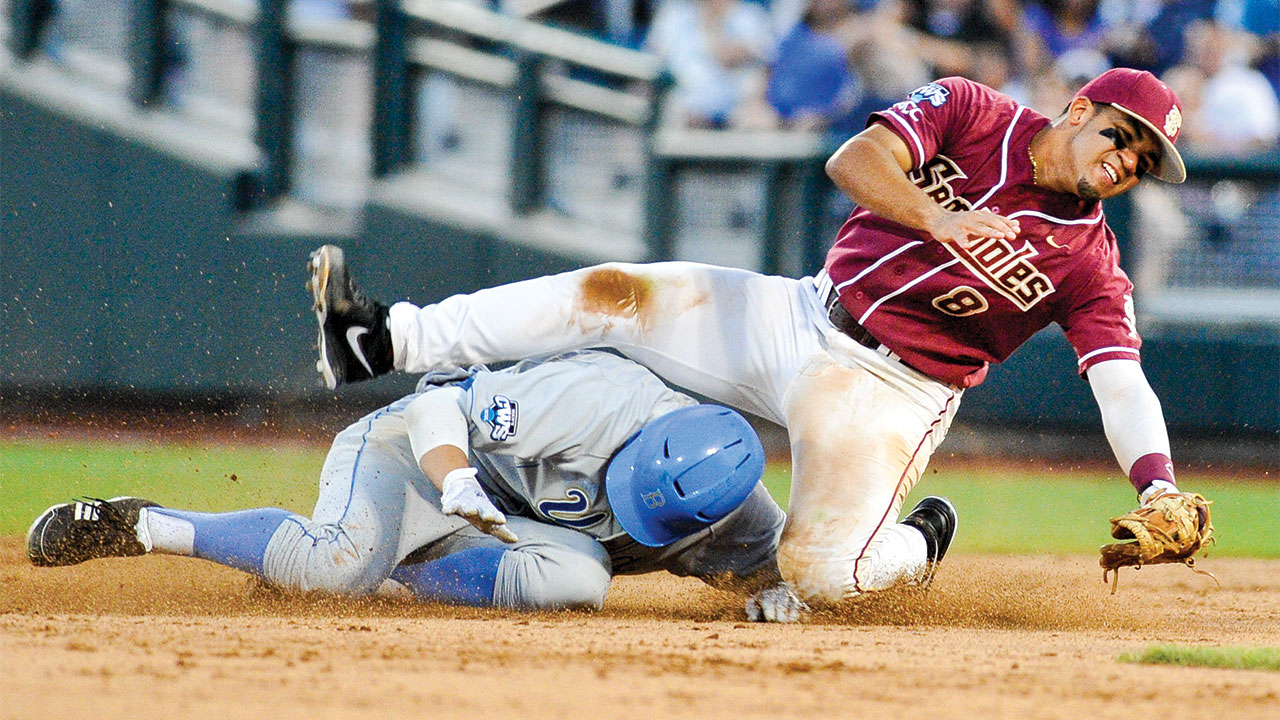
Devon Travis has been fixated on the big leagues ever since he was a four-year-old playing T-ball. Now that he’s finally made it, he has zero plans to slow down.
By Arden Zwelling in Baltimore and Toronto
Knock, knock, knock. “Is Ramsey up yet?”
It was 8:15 a.m. on a charming Florida Saturday when little Devon Travis, all four-foot-nothing of him bouncing with puppy-like energy, ran up and down his block, trying to play some ball. Travis was always the first one up in his house, well before his mom and dad. He’d inevitably wake them up with his racket, but he had to wait until at least eight before he was allowed to go bother anyone else.
Knock, knock, knock. “Is Cameron out of bed?”
Plenty of kids lived in the West Palm Beach cul-de-sac where Travis grew up. They played all kinds of games—road hockey, basketball, hide-and-seek. But Travis always wanted to play baseball.
Knock, knock, knock. “Is ‘Big Cameron’ around?”
On most Saturdays, he’d have corralled 15 kids by 9 a.m. and they’d be out there all day, going at it. “If the sun was up, Devon was outside, rounding up the neighbourhood,” says Tammy, Travis’s mother. “From the moment he could hold a glove and a ball, he wanted to be out there. It started when he was four. And it just never stopped.”
You get the sense that Travis can’t stop. Before he was even in kindergarten, his entire day revolved around the ballpark. From fields without stands in West Palm Beach to 6,000-seaters in the NCAA to Toronto’s Rogers Centre and its space for 48,000, Travis never feels more at ease than he does on the diamond. Even though he profiles more as a running back than a ballplayer—five-foot-nine, stocky torso, huge glutes, strong legs—it’s where he’s meant to be. So it comes as little surprise to those who know him well that all he needed was an opportunity. “I’ve never had so many people come up to me and say, ‘Isn’t it great about this guy getting a chance in the big leagues?’ as I have with Devon Travis,” says Mike Martin, who coached Travis at Florida State University. “Everybody loved Devon. It’s real easy to pull for him. He’s such a special young man. He’s just one of those people who fans, those close to the program, everyone, thought the world of.”
Still, it’s easy to forget that when he showed up at Blue Jays spring training in late February, Travis wasn’t supposed to make the team. The 24-year-old sat in a row of non-roster invitees along a far wall of the clubhouse, all of them wearing uniforms with numbers in the 70s. He’d never played above double-A and was presumed to be headed back to the minors. But as camp wore on and his hits piled up, Travis found himself with more and more room as more and more players from his row were sent to minor-league camp, while he remained. Then they told him he’d made the team.

Family first “He’s a little shy,” says Travis’s mom, Tammy, pictured here with Travis and his sister, Jada. Both of Travis’s parents helped him hone his skills, and the whole family accompanied him to tournaments. “Dad was the coach and I was the cheerleader,” she says.
And all he’s done since is prove the Blue Jays right. He hit a home run in his first ever major-league game and had seven by the third day of May, matching the total put up by all Blue Jays second basemen in 2014. He hit .325 in April with an absurd 1.018 OPS, a rate of production that made him the easy choice for American League rookie of the month. He put to rest any concerns about his defensive ability, posting an ultimate zone rating of 1.7 through mid-May, good for eighth among the 92 players who had manned second base in 2015. And, perhaps most importantly, he brought hope that the Blue Jays could have a franchise second baseman for the first time since Roberto Alomar. “He’s really amazed us with what he’s done,” says Blue Jays manager John Gibbons. “He’s hit from day one, played great defence, great baserunning, head’s in the game, always paying attention. You know, we thought he could be good, but we didn’t expect this.”
Of course, he’s perpetually exceeding expectations. Despite always being smaller than his peers, Travis played up his entire life, starting T-ball at four in the only league his parents could find that would take a kid that young. He played travel T-ball at five, bussing out to Miami for games. He played 10-and-under at eight; 12-and-under at 10; 14-and-under at 12. He went to the Little League World Series in 2003 with a team from East Boynton Beach, Fla., where he sometimes played catcher because he was the only one who wouldn’t let pitches get past him when his friend Michael Broad, who threw 83 mph as a 12-year-old, was on the mound. He made the varsity team at Palm Beach Central as a freshman and hit .367 against kids three years older than him. By his senior year, he was batting .483.
Much of his drive came from his dad, Tony, a detective with the sheriff’s office for 28 years who drilled it into his son that he had to always take one more swing than the competition. They’d work on his game all day long. When Travis had Little League doubleheaders, he’d be up early in the morning, putting on the uniform he’d laid out the night before and packing the cooler full of drinks and snacks and hauling it to the front door well before he had to leave. He’d play his first game at 10 a.m. and another at noon. When he got home at 3 p.m., he’d go straight to the garage with his dad to drive balls off a tee into a net. Then they’d go to the diamond, where Tony would pitch to him while Tammy fielded the balls he barrelled to the outfield. When Travis worked on his pitching, Tammy would stand in as the batter to give him a better idea of the strike zone.
Travis was an anxious kid, worrying himself sick if his parents were ever late for one of his games. One time, when Tony and Tammy were running late for a tournament, he suffered a panic attack at the field, convinced his parents had been in a car accident. He only calmed down once another parent got them on the phone to reassure him they were OK. “I was like a hypochondriac,” Travis says. “I was always freaking out about stuff. My family was my everything.” When Travis left for college to study marketing and play ball at FSU—he was the starting second baseman as a freshman—Tony and Tammy leased a Honda Accord in Seminoles burgundy with tan interior specifically for the purpose of driving the 650 km to his games in Tallahassee, Fla., every weekend. They would take Fridays off work and even pull Travis’s brother and sister, Jordan and Jada, out of school to make the trips.

One day, while Travis was manning second base for the Seminoles, Blue Jays scout David May was on a treadmill in Delaware, watching FSU play Stanford in the NCAA super regional. Mark Appel was pitching for Stanford and had been projected to be the No. 1 pick in that year’s MLB draft. May watched as a short Seminoles second baseman hit homers off Appel in each of his first two at-bats, driving in six runs. “I see this guy having no problem catching up to his fastball. Taking good at-bats,” May says. “I was like, ‘Wow. That’s impressive.’ ” A few months later, May was scouting the Detroit Tigers at the Florida Instructional League when a diminutive second baseman caught his eye again. “I was like, ‘Oh hey, that’s that kid,’” May says of Travis, who was drafted by Detroit in the 13th round in 2012 and chose to leave FSU before his senior year when the Tigers offered him a $200,000 bonus. “I was kind of drawn to him. He didn’t look all that good at the time, to be honest. But there was something about him.” Travis would once again pop up on May’s radar the year after, while playing for single-A West Michigan in the Midwest League. He hit .352 that year, with a .912 OPS. “He was playing extremely well. Taking really good at-bats, advanced approach at the plate, high energy, good defence,” May says. “I put a five on him right then.”
A five is a score on the scouting scale, given to a prospect the scout believes could be an everyday player on any team in the majors. May doesn’t hand out many fives. The report worked its way to Blue Jays cross-checker Kevin Briand, who went to see Travis play in the Midwest League All-Star Game, where Travis was named the game’s MVP after contributing a single and a three-run triple. Briand called May and said Travis came exactly as advertised.
The Blue Jays, who had been searching to no avail for an everyday second baseman ever since Aaron Hill was traded in 2011, came close to acquiring Travis in 2013, getting some interest from the Tigers but ultimately failing to close the deal. Two years later, Detroit needed a centre fielder. And Toronto had a spare one in Anthony Gose. Blue Jays director of professional scouting Perry Minasian saw Travis at the top of May’s prospect preference list this past winter and called the scout, telling him about the Gose-for-Travis possibility, and asking if he should pound the table for Travis. “I was like, ‘Absolutely,’” May says. “This kind of guy is hard to find.”

Bust a Pose Mike Martin, Florida State’s head coach, says Travis’s work ethic and consistency reminded him of an earlier star at FSU, Buster Posey. “I get up in the morning and I look at the box scores for Travis and Posey—then everybody else,” he says. “Those two guys are special.”
Travis calls the trade the best thing that’s ever happened to him, primarily because of what happened on the last day of March. He was eating breakfast at the Blue Jays’ spring training facility when he was called into the manager’s office. Inside, he found Gibbons, Blue Jays GM Alex Anthopoulos and bench coach DeMarlo Hale waiting for him. Gibbons did most of the talking. “We’re bringing you north. But you have to understand that in the big leagues, there’s ups and there’s downs,” Gibbons told him. “Through it all, you have to believe. If you aren’t believing in yourself, you have no shot.” Travis says that advice has helped carry him through his first dose of major-league adversity, which began on the final day of that magnificent April, when a sharp ground ball jumped up and caught him square in the left collarbone, leaving him with a deep bone bruise. Travis tried playing through the pain for more than two weeks, but he couldn’t finish his swings, and his offensive production suffered greatly, eventually forcing him to the DL in late May, where he remained for more than a month before returning in late June. He’s a more tranquil guy now, no longer the bundle of nerves that he was in his youth. He still hates sitting out, but his talk with Gibbons gave him better perspective on it. “Gibby really drove home that you can’t get too down on yourself,” Travis says. “You just have to push through the tough times. That really stuck with me.”
When Travis walked out of that meeting with Gibbons, he sent a group text to his parents and siblings. “Hey, I want to thank you guys for everything you’ve done for me,” Travis wrote. “I just got the best news of my life.” They were all there in New York when Travis walked to the plate to lead off the seventh in his first big-league game and hit a 90-mph fastball from reliever Chasen Shreve into the left-field seats. He still hasn’t watched a replay of it. He doesn’t want to get too caught up in his own success. “That moment was like dream stuff,” Travis says. “I still don’t really believe it happened.”
That night, Travis went out to dinner with his agent and 25 friends and family members who made the trip up from Florida to see him play. His parents were there with Jada and Jordan, just like they’d been on Little League nights in West Palm or college weekends in Tallahassee. There were aunts and uncles, godparents and a few friends from the cul-de-sac. He looked around the table and thought about the day he was having. That’s when it sunk in. “Hitting that ball and everyone being there for it—you’re doing something you’ve dreamed of forever. It’s crazy,” Travis says. “It just hit me right there. It’s a beautiful game that we play. Yes, it’s our job. And it’s a tough business. But it’s a game first. It’s the same game I’ve played since I was four years old.” Since he was little Devon Travis, running door-to-door, waking up the neighbourhood, trying to play some ball.
This story originally appeared in Sportsnet magazine.
Photo credits: David Cooper/Toronto Star/Getty/Melissa Lyttle/South Florida Sun Sentinel/Rob Tringali/Getty; GENE J. PUSKAR/AP/Eric Francis/Ap




Almost Done!
Please confirm the information below before signing up.
{* #socialRegistrationForm_radio_2 *} {* socialRegistration_firstName *} {* socialRegistration_lastName *} {* socialRegistration_emailAddress *} {* socialRegistration_displayName *} By checking this box, I agree to the terms of service and privacy policy of Rogers Media.